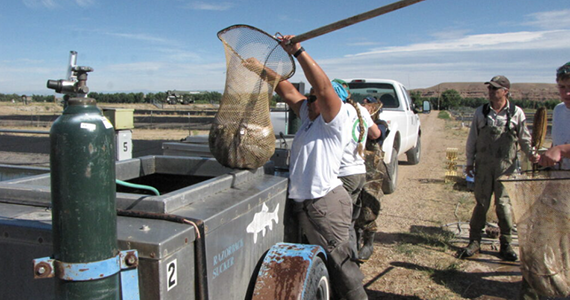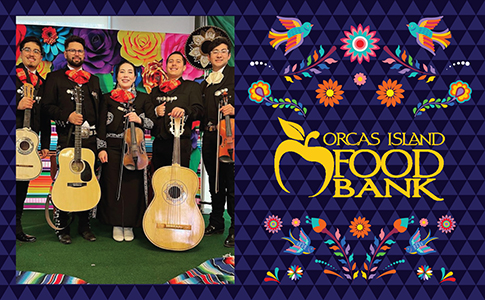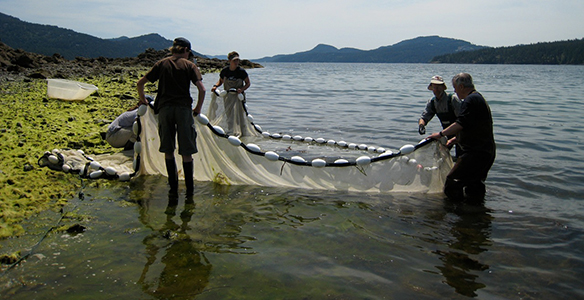More than 200 studies across 40 years revealed large-scale salmon hatchery programs weaken wild salmon diversity and lead to wild population declines
||| FROM OREGON CAPITAL CHRONICLE |||
For much of the last century, fish hatcheries have been built in the Northwest, across the U.S. and around the world to boost fish populations where wild numbers have gone down.
But an analysis of more than 200 studies on hatcheries programs meant to boost salmonid numbers across the globe – including salmon, trout and whitefish – shows that nearly all have had negative impacts on the wild populations of those fish. Most commonly, hatchery fish reduced the genetic diversity of wild fish, leading to poor health and reproductive outcomes.
The findings weigh into a sensitive topic with a big price tag. In the Northwest, hatcheries are supposed to be a solution to declining wild salmonid numbers, caused in large part by hydroelectric dams, overfishing, irrigation and climate change. In the Columbia River Basin alone, officials have spent billions of dollars on nearly 200 hatcheries as well as habitat restoration projects during the past 50 years to improve wild numbers, but research shows those programs are having an opposite effect.
The global studies, all undertaken between 1971 and 2021, were analyzed by scientists at the nonprofits Trout Unlimited, based in Virginia, and The Conservation Angler, out of Washington, along with the University of Washington, the University of Montana and the Université Laval, in Quebec, Canada. Their analysis was published in July in the journal Fisheries Management and Ecology.
Of the 206 studies the team analyzed, more than 80% revealed hatcheries programs had adverse effects on wild salmonids. Of the 3% of hatcheries globally that were found to benefit wild populations, the majority were stocked with wild fish who were bred and released in small numbers to boost severely depleted wild populations.
John McMillan, science director at The Conservation Angler who worked on the analysis, said the team wanted scientists all over the world who are studying the same fish species to see the impact of hatcheries programs beyond their regions of study. He said despite an overwhelming body of research showing most hatcheries programs hurt wild fish populations, it’s often controversial to criticize such programs.
“It’s frustrating from a scientific point of view, because you can see what the science suggests, but it’s understandable why we’ve been reluctant to move our position on hatcheries, because of the social implications,” he said. “This is one of those things, like climate change, where we have to sit back and think about our relationship with the animal, what it means to us and how much we want to give up so these animals can truly, potentially rebuild themselves.”









It is a basic principle of ecology that everything is connected to everything else. This is why it is ultimately fruitless to focus on any one species or subspecies if nothing is simultaneously being done to preserve or restore the ecosystem(s) that the species forms a portion of. For example, there is no long term point to raising hatchery salmon, even if they are raised from eggs collected from wild salmon, if their native forest/stream ecosystem is not also healthy. That means free flowing rivers, mature forests, healthy populations of bears, ravens, yellow jackets, fungi, etc. And as anadromous fish, all salmon live in two worlds; the forest and the sea. So, for healthy salmon runs, there must also be a healthy North Pacific ocean for that portion of their lives.
Rather than wasting money raising hatchery fish for “sportsmen” to catch, the entire biome would be better off if we worked on projects that improve the health, diversity and vitality of both the North Pacific ocean AND the Cascadia’s forests and streams. But we must be prepared to accept that the biome we will be living in by 2050 is not going to be the same as it is now, nor will it ever go back to what it once was; it can’t.
Even if we took our role as Stewards of the Earth seriously, which of course we don’t, at least collectively, the best we can do is help the whole system evolve in the direction of greater diversity and greater resilience. One good start would be permanently ending commercial logging and the removal of all roads from our State and National Forests. Expanding roadless areas, wilderness areas, and removing dams wherever possible will all be required to restore even a fraction of the salmon runs that once were a vital part of the Pacific Northwest/Cascadia. And THAT would be good for ALL the members of the ecosystem, including the humans!
This wasn’t taught when I was in school in and around Seattle 60 or more years ago, but it’s becoming more generally understood that the places we (European/settler types) regarded as uninhabited wilderness were actually managed by the local tribes very deliberately. Think clam gardens, now beginning to be re-established, or camas meadows, or the forests. Those were not fenced off to keep all people out and allowed to grow at random. I often think, when I am walking the trails in Moran Park, what the elders of the local tribes would think about how the park had evolved over the past century without the tending it might have had if the tribes had remained in charge.
In some places we’ve begun to experiment with allowing — even encouraging — “cultural burning” as a method of managing woodlands to reduce fuel loads and hopefully mitigate the intensity of wildfires when they do occur in those places. So far the results are promising. In addition those traditional practices generate more productive areas for wildlife.
I wonder if or how it might be possible to reintroduce some of the traditional forest management practices on some public lands here in the islands, perhaps with guidance and participation from tribal groups.
I strongly encourage reading NOT ON MY WATCH for detailed research and lifetime efforts of Alexandra Morton…” who came north from California in the early 1980s, following her first love—the northern resident orca. Then, in 1989, industrial aquaculture moved into the region, chasing the whales away. Soon Alex had shifted her scientific focus to documenting the infectious diseases and parasites that pour from the ocean farm pens of Atlantic salmon into the migration routes of wild Pacific salmon, and then to proving their disastrous impact on wild salmon and the entire ecosystem of the coast” .
The book is in the Orcas Library.